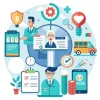
NABH Audit Checklist For Hospitals: Ensure Compliance & Quality
In today’s healthcare landscape, maintaining high standards of quality and observation is important. One of the crucial tools to achieve this is sticking to the NABH (National Accreditation Board for Hospitals and Healthcare Providers) standards.
This article provides a thorough NABH audit checklist for hospitals to ensure that your healthcare facility meets the rigid standards set by NABH, thereby ensuring compliance and improving the quality of care provided to patients.
What is NABH Accreditation?
The NABH accreditation is a symbol of excellence in healthcare, indicating that a hospital sticks to the highest standards of quality and patient safety. The accreditation process involves a thorough evaluation of the hospital’s systems, processes, and outcomes. A strong NABH audit checklist for hospitals is essential for guiding institutions through this examination.
Importance Of NABH Audit In Hospital
Before diving into the checklist, it is crucial to understand the importance of the NABH audit. This audit is designed to evaluate a hospital’s commitment to established standards and protocols, ensuring patient safety, quality of care, and continued improvement. Successfully passing the NABH audit not only boosts a hospital’s reputation but also enhances patient trust and satisfaction.
NABH Audit Checklist for Hospitals
Here is a detailed NABH audit checklist for hospitals to guide you through the accreditation process:
1. Hospital Governance and Leadership
Documentation of Policies and Procedures
- Ensure that all hospital policies and procedures are well-documented and easily available.
- Regularly update policies to reflect current best practices and regulatory requirements.
Leadership Involvement
- Hospital administration should actively participate in the NABH accreditation process.
- Hold regular meetings to review progress and address issues.
2. Patient Care and Safety
Patient Admission and Discharge Procedures
- Ensure clear protocols for patient admission and discharge.
Medication Management
- Implement strict medication management protocols to avoid errors.
- Regular audits of medication administration should be conducted.
Infection Control Measures
- Establish strong infection control protocols.
- Regularly train staff on infection control practices.
Patient Identification
- Use standardized methods for patient identification to avoid mix-ups.
- Regularly audit observance with identification protocols.
3. Clinical Services and Quality Management
Clinical Pathways
- Develop and implement clinical pathways for common conditions.
- Ensure pathways are based on current best practices and evidence.
Emergency Services
- Maintain a well-equipped emergency department.
- Ensure staff are trained to handle emergencies efficiently.
Continuous Quality Improvement
- Establish a continuous quality improvement program.
- Regularly review clinical developments and implement changes as needed.
Patient Feedback
- Actively analyse and improve patient feedback.
- Implement changes based on feedback to improve patient care.
To streamline patient feedback and drive quality improvements, hospitals can integrate real-time solutions like LazyMonkey’s Hospital Feedback System, designed to meet NABH standards with QR-based ease.
4. Staff and Training
Adequate Staffing Levels
- Maintain sufficient staffing to meet patient needs.
- Regularly review and adjust staffing levels according to patient volume.
Staff Competency
- Regularly evaluate staff skills and provide needed training.
- Maintain proper records of staff training sessions and certifications.
Ongoing Training
- Implement ongoing training programs for all staff.
- Ensure training covers all aspects of patient care and safety.
5. Infrastructure and Facility Management
Facility Maintenance
- Ensure regular inspections and maintenance of hospital facilities.
- Ensure that all hospital equipment is well-maintained and operational.
Safety Measures
- Fire Safety and Emergency Preparedness
- Implement and regularly review fire safety protocols.
- Conduct regular emergency drills to ensure staff readiness.
Environmental Safety
- Ensure the hospital environment is safe and clean.
- Regularly monitor and address potential safety hazards.
6. Information Management Systems
Record Keeping
- Electronic Medical Records (EMR)
- Implement and maintain an efficient EMR system.
- Ensure data accuracy and security.
Data Analysis
- Regularly analyze clinical and operational data to identify improvement areas.
- Use data to drive decision-making and improve patient care.
Conclusion
Achieving NABH accreditation is a relentless process that requires careful planning and execution. By following this complete NABH Audit Checklist for Hospitals, healthcare institutions can ensure they meet the necessary standards and provide the highest quality of care to their patients.
Remember, continuous improvement and commitment to established protocols are key to maintaining accreditation and improving patient feedback.
NABH accreditation requires structured feedback collection. LazyMonkey’s patient feedback software automates this process, ensuring compliance effortlessly.
Frequently Asked Questions
What Is The Purpose Of The NABH Audit?
The NABH audit aims to evaluate a hospital’s adherence to quality and patient safety standards, ensuring continuous improvement and excellence in healthcare.
How Often Should Hospitals Undergo The NABH Audit?
Hospitals should undergo the NABH audit every three years to maintain their accreditation and ensure ongoing compliance with updated standards.
What Are The Key Areas Assessed In The NABH Audit?
The NABH audit assesses various areas, including hospital governance, patient care and safety, clinical services, quality management, staffing and training, infrastructure, and information management systems.
How Can Hospitals Prepare For The NABH Audit?
Hospitals can prepare for the NABH audit by following a detailed checklist, conducting regular internal audits, and ensuring all staff are trained and aware of the accreditation requirements.
What Are The Benefits Of NABH Accreditation For Hospitals?
NABH accreditation enhances a hospital’s reputation, improves patient trust and satisfaction, ensures compliance with quality standards, and promotes continuous improvement in healthcare delivery.
Enhance Patient Care and NABH Compliance with LazyMonkey
LazyMonkey is your all-in-one solution for improving patient care, retaining more patients, and meeting NABH standards. Our powerful QR-based feedback tool enables you to capture real-time insights from patient feedback, discharge surveys, staff and doctor evaluations, and clinical research, while also streamlining inter-departmental communication.
Transform your healthcare facility today - reach out to us at hello@lazymonkey.in, or request a demo here!
Elevate Your Restaurant Experience with LazyMonkey
LazyMonkey’s QR-based feedback system helps you gather real-time insights from customers, track satisfaction levels, and enhance the dining experience. Get instant feedback on your menu, service, and ambience, and make data-driven improvements to boost repeat customers and reviews.
Improve your restaurant today – reach out to us at hello@lazymonkey.in, or request a demo here!
Empower Student Engagement and Campus Improvement with LazyMonkey
LazyMonkey offers a seamless way to gather student feedback, track satisfaction, and enhance campus life. From course evaluations to dorm feedback, our QR-based solution makes it easy to capture valuable insights and improve student retention.
Upgrade your university experience – contact us at hello@lazymonkey.in, or request a demo here!
Streamline Feedback and Drive Performance Across Your Enterprise/Franchise with LazyMonkey
Whether you manage one or multiple locations, LazyMonkey’s QR-based feedback system helps you gather real-time employee and customer feedback. Improve operational efficiency, track satisfaction, and make data-driven decisions to enhance brand consistency and growth.
Transform your franchise today – reach out to us at hello@lazymonkey.in, or request a demo here!
Enhance Customer Satisfaction and Service Standards in Banking with LazyMonkey
LazyMonkey empowers banks to capture real-time feedback from clients across branches. Improve customer experience, assess service quality, and ensure regulatory compliance with our QR-based solution, helping you retain clients and meet banking standards.
Elevate your bank’s customer care – contact us at hello@lazymonkey.in, or request a demo here!
Boost Customer Engagement and Mall Satisfaction with LazyMonkey
LazyMonkey’s QR-based feedback tool enables you to collect feedback from shoppers, track satisfaction, and enhance the mall experience. Gather insights on store services, cleanliness, and entertainment to create an unmatched customer journey.













